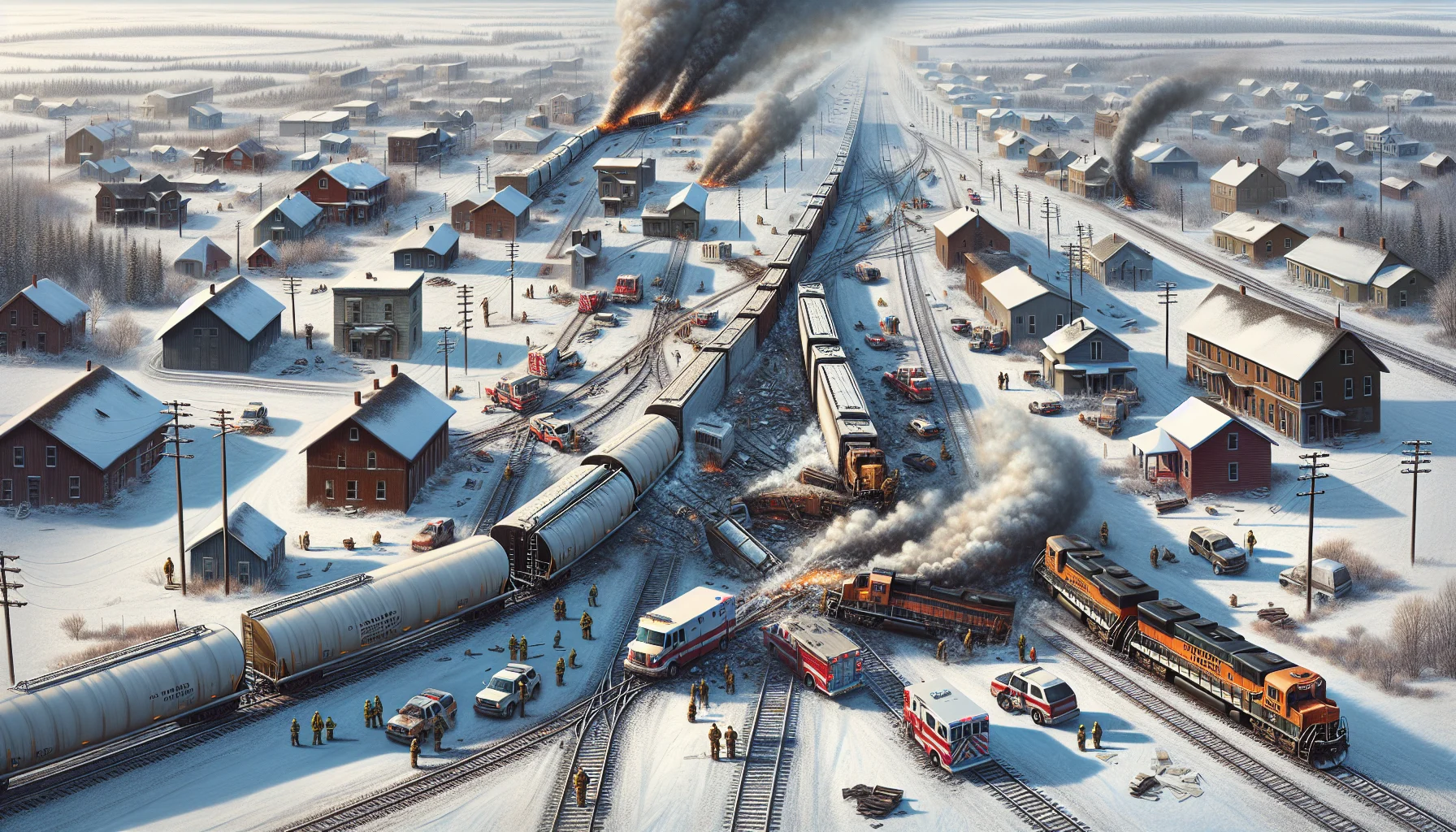
East Palestine, Ohio, Train Derailment
by: The Calamity Calendar Team
February 3, 2023
In the quiet village of East Palestine, Ohio, a close-knit community lived its day-to-day life, bordered by the pastoral beauty of northeastern Ohio. On February 3, 2023, their serene existence became the backdrop for events that would thrust them into national headlines. The clattering of train wheels on steel rails was familiar in a town intersected by major transport routes, but on this evening, the sound would signal a disaster few were prepared to face.
Prelude to Catastrophe
The Norfolk Southern freight train embarked from Madison, Illinois, on its routine journey to Conway, Pennsylvania. With a fleet of 141 loaded cars, 9 empty ones, and powered by 3 locomotives, the freight was laden with goods that included hazardous materials. The train followed federal safety protocols, emphasizing cautious handling of such dangerous cargo. Yet, a piece of machinery—a single axle—held the potential to undermine these precautions.
Unknown to the crew, a mechanical issue lurked under the vast train’s substantial weight. This axle problem would soon unleash a chain of events that no transcontinental policy could fully anticipate.
The Turning Point: Derailment
At precisely 8:54 PM, amidst an otherwise typical winter night, calamity struck. Thirty-eight of the freight cars derailed as the train rolled through East Palestine. The abrupt cessation of metal on track was deafening, the impact thunderous. As the cars careened off course, hazardous substances from 11 cars threatened to transform the derailment into a full-blown disaster, spilling their contents and igniting a towering inferno.
Vinyl chloride, a highly flammable and carcinogenic compound, was among the materials in the derailed cars. The fire that erupted sent plumes of smoke swirling upward, a grim beacon visible for miles around. The echo of emergency sirens pierced the chilled air as local first responders hurriedly assembled to confront the blaze and prevent a catastrophe from worsening.
Emergency Mobilization
The ensuing hours saw an elaborate network of emergency response spring into action. Firefighters from the surrounding areas convened in the village, battling the relentless flames with equal parts caution and urgency. Hazmat teams donned their protective suits, aware that the chemicals' volatility required careful management.
Thanks for subscribing!
Local authorities faced the immediate challenge of protecting the residents while allowing efforts to contain and control the toxic flames. Leaders quickly decided on a precautionary evacuation within a one-mile radius of the site. Residents gathered belongings, pets, some even clutched heirlooms, and departed from their homes, uncertain of what they would return to find.
A Tactical Intervention
By February 6, the stakes heightened. The potential for an uncontrolled explosion loomed as the remaining vinyl chloride posed an imminent threat. Experts from multiple agencies agreed on a radical but necessary step: a controlled release and burn-off. The preemptive action would prevent a broader disaster but not without some formidable pyrotechnics.
The operation unfolded with a furious blaze lighting the horizon, as flames entwined with black smoke soared toward the sky, a stark reminder of the event’s gravity and scale.
The Aftermath and the Echoes of Impact
The toll on East Palestine was multifaceted. Financially, the derailment scarred the local economy with millions of dollars pegged for repairs and environmental remediation. Norfolk Southern, in collaboration with federal agencies, initiated work on environmental assessments and restoring track integrity.
Environmental repercussions extended far beyond the scorched earth. Numerous tests of air and water highlighted the persistent threat posed by lingering chemicals. The EPA and corresponding agencies undertook rigorous monitoring, attempting to assure the community that their land and lives could revert to normalcy. For some residents, trust lagged behind reassurances.
Waterways reverberated with the derailment's imprint, with reports of fish and wildlife casualties underscoring the depth of environmental harm. Although no human fatalities occurred, health concerns lingered among townspeople who experienced the exposure firsthand.
Towards Recovery and a Safer Future
Norfolk Southern and environmental agencies anchored the recovery efforts—workshops for addressing public concerns, ongoing monitoring, and constantly iterating plans to improve safety measures marked their calendar in the weeks following. Dialogue on rail safety standards gained momentum, mushrooming into calls for stringent legislative review and reform.
Community advocates, galvanized by the near miss, became pivotal voices for change. Their emotive accounts and appeals provided the human dimension often overshadowed by the bureaucratic language of safety reviews and protocols.
The event in East Palestine stands as an indelible reminder of the synergy between safety, environment, and community welfare. It highlighted both the vulnerabilities inherent in modern transport networks and the resilience of a community when thrust against adversity.
As investigations into the derailment continued, including a meticulous NTSB study into the mechanical failure, hope emerged quietly amidst recovery efforts. The town of East Palestine, poised next to the tracks intimately woven into its identity, began the road to healing. Therein lies a narrative of caution, community resolve, and an unwavering insistence that such an event should never recur unchecked.
Looking Ahead
Beyond immediate mending, the lessons learned linger with policymakers and citizens alike, thousands of lives still rooted in their hometown. East Palestine became a crucible for change—a call for renewal in the fashioning and monitoring of railways tasked with carrying dangerous materials through peaceful communities.
As the rails receive new gossamer threads of steel, as air and water tests produce reassuring numbers, as homes refill with the everyday noises of life rekindled, the people of East Palestine remain watchful and hopeful, bearing the rallying cry for safety's ascendancy in all the places trains might journey next.
Stay in the Loop!
Become a Calamity Insider and get exclusive Calamity Calendar updates delivered straight to your inbox.
Thanks! You're now subscribed.